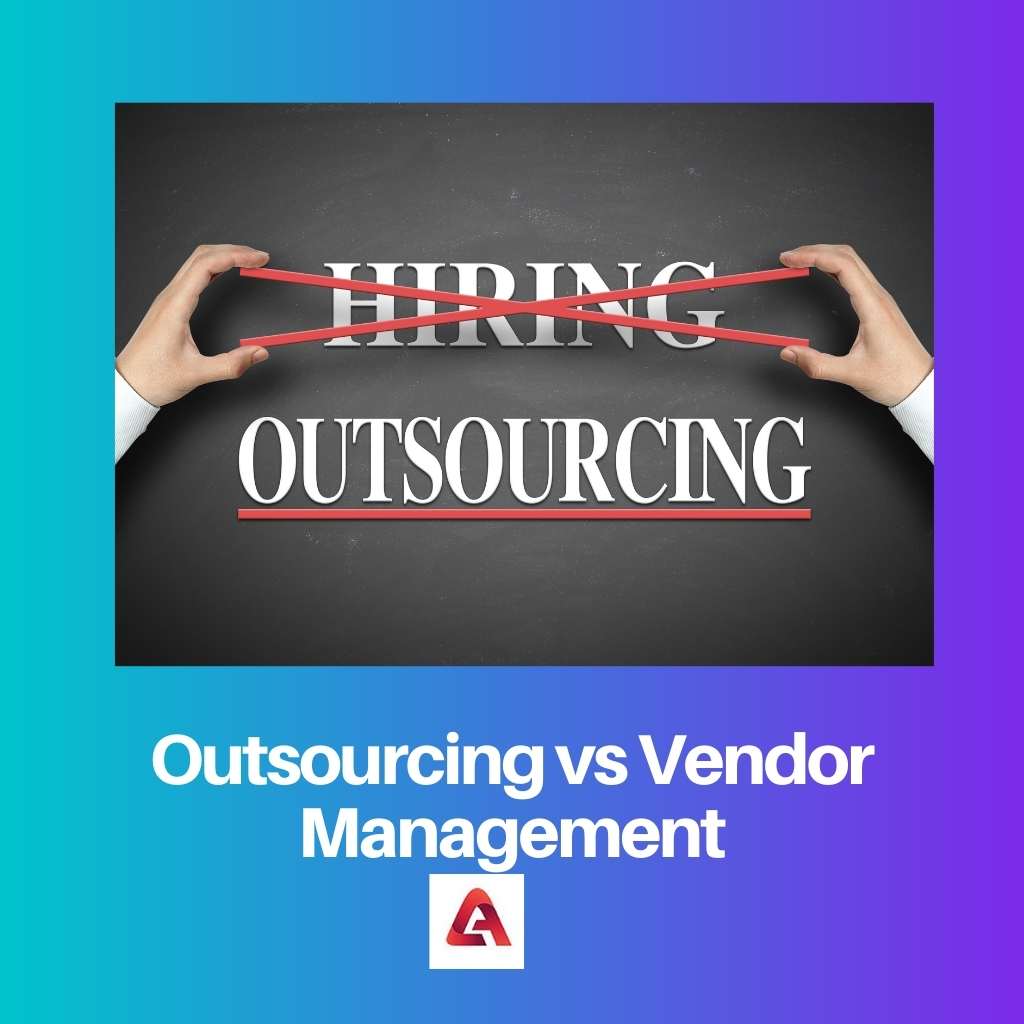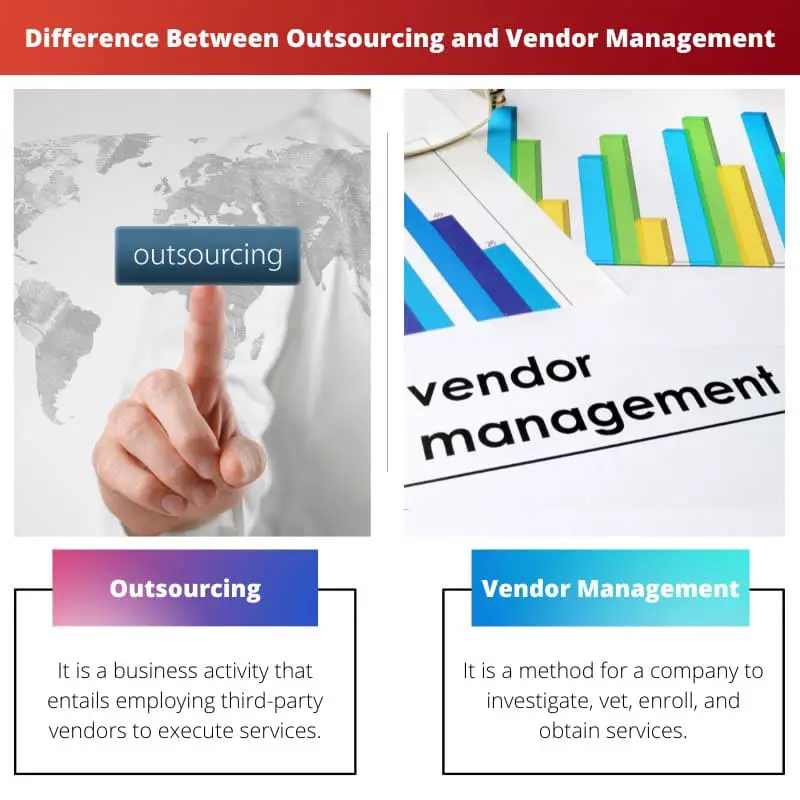Business administration is an essential important activity in every corporation, regardless of size or occupation. It improves cost containment, risk reduction, and contingency planning.
Given the difficulty of the undertaking, several strategies, such as outsourcing and vendor management, may be used depending on individual business choices and the number of activities concerned.
Key Takeaways
- Outsourcing involves delegating business processes to external companies, while vendor management focuses on maintaining effective supplier relationships.
- Businesses outsource to reduce costs and improve efficiency and specialized access expertise; effective vendor management ensures quality, cost-effectiveness, and compliance.
- Outsourcing can involve various business functions, while vendor management spans multiple vendors, including outsourced service providers.
Outsourcing vs Vendor Management
Outsourcing is the practice of contracting out a business function or process to a third-party provider. This can include services such as customer support, IT, accounting, and manufacturing. Vendor management refers to the process of selecting, evaluating, and managing the relationship with third-party suppliers. Vendor management includes activities.

In outsourcing, established banks that want to maximize shareholder capital outsource to enjoy the benefits of a range of advantages.
A bank can swiftly enhance the integrity of its offerings, boost operational or budgetary efficiency, and, in many circumstances, cut costs using outsourcing to skilled service offerings.
Outsourcing may indeed help bank administration to emphasize more on primary product tasks, boost the accessibility of bank facilities, and speed their delivery.
Vendor management refers to the practices that businesses employ to govern their contractors, recognized as vendors.
Selecting suppliers, negotiating deals, regulating prices, decreasing vendor-related hazards, and guaranteeing customer experience are all examples of vendor management operations.
Its application by a firm would vary greatly relying on the type of the organization and might include businesses as different as seafood exporters, IT providers, cleaners, and marketing strategists.
Comparison Table
| Parameters of Comparison | Outsourcing | Vendor Management |
|---|---|---|
| Definition | It is a business activity that entails employing third-party vendors to execute services. | It is a method for a company to investigate, vet, enroll, and obtain services. |
| Performed | It is carried out in-house by the firm staff. | It is carried out to assure the delivery of services. |
| Operations | Operations include handling all areas of a company’s operations. | It entails recruiting and verifying various vendors for various company tasks. |
| Advantages | It saves time and money by making resources and skills accessible, focusing on key capabilities and tactics, and so on. | A wider pool of suppliers allows for greater choices, well-managed vendor contracts, assured value for money invested, and so on. |
| Challenges | When another entity has exposure to a company’s private files and later experiences a data leakage, security issues arise. | Challenging for companies with a broad supplier base and geographical reach to acquire a consolidated picture of the providers. |
What is Outsourcing?
Outsourcing is a commercial technique in which outside parties are hired to undertake activities that were previously conducted in-house by the corporate team.
Despite this strategy having caused criticism in many nations owing to job losses, it is widely used as a cost-cutting approach.
It is also used to concentrate on more crucial company concerns while outsourcing less significant ones.
IT solutions, financial operations, industrial, and human resource processes are just a few categories of corporate activities that are routinely outsourced.
Outsourcing may dramatically lower labor expenses for corporations. When a corporation utilizes outsourcing, it enumerates the assistance of non-affiliated outside organizations to execute certain responsibilities.
Outside businesses have different remuneration arrangements in place with their personnel than the outsourcing organization, allowing them to accomplish the task for less money.
As a result, the firm that elected to outsource is entitled to reduce its labor expenditures.
Businesses can also save money on overhead, machinery, and innovation.
Aside from cost savings, businesses may use an outsourcing approach to better emphasize the essential components of the industry.
Outsourcing non-core operations can boost effectiveness and production since another institution can handle these minor jobs better than the company.
This method may also result in shorter development cycles, enhanced economic competitiveness, and lower ultimate operating costs.

What is Vendor Management?
Vendor management is a strategy that allows a company to do research, assess suppliers, and get solutions from a variety of sources, hence assuring service reliability.
Vendor management includes, among other things, job responsibilities, contract agreements, payment distribution, performance assessment, and relationship building.
There have been several vendor management technologies created.
This strategy offers several advantages, including a wider pool of suppliers for improved picking, a well-managed procurement strategy,the ability to compile a report for vendors predicated on accomplishment, and assured value for money expended.
Vendor management is essential for a variety of purposes. For one instance, when it pertains to picking the correct vendor for a certain business requirement, vendor management is critical.
It might be challenging to acquire a consolidated picture of a company’s vendors when it has a vast sourcing strategy and/or a complicated geographical presence.
Challenges might develop at any point during the vendor management system, from obtaining the proper documents from suppliers to doing the appropriate risk evaluations.
To avoid problems, it is critical to use appropriate processes and instruments.
Vendors must also be successfully managed to limit the likelihood of supply conveyor interruption and to guarantee that products and services are fulfilled on schedule and to the desired level.
Aside from that, a good vendor management strategy may assist businesses in developing deeper connections with their vendors, which may contribute to possibilities to bargain better pricing.

Main Differences Between Outsourcing and Vendor Management
- In outsourcing, the management includes supervising all aspects of a company’s administration. Whereas vendor management encompasses recruiting and verifying numerous vendors for certain company activities.
- Outsourcing is conducted in-house by the corporate crew. Whereas vendor management is performed out to guarantee the implementation of commodities.
- Outsourcing minimizes time and cash by providing knowledge and capabilities more transparent, concentrating more on core competencies and tactics. Whereas in vendor management, a broader pool of merchants allows for greater selection, well-managed procurement strategy, assured value for cash expended, and so on.
- outsourcing is a commercial activity that incorporates recruiting third-party vendors to undertake operations. While vendor management is a technique for an enterprise to evaluate, examine, mobilize, and access the services.
- In outsourcing, when another individual has accessibility to a corporation’s residential material and afterward undergoes a data theft, security threats arise. Whereas vendor management can be complicated for organizations with a vast supplier network and geographical coverage to establish an aggregated picture of the manufacturers.




